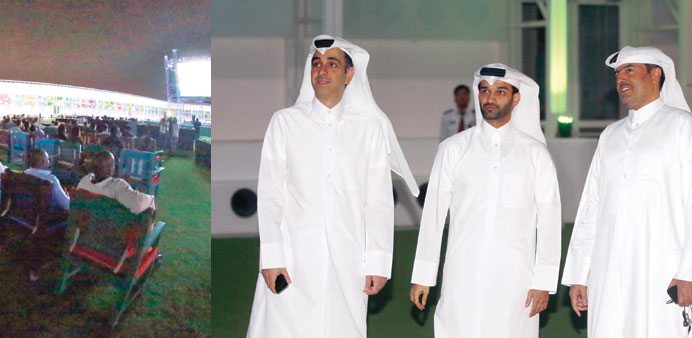In line with a promise to deliver an amazing fan and player experience at the 2022 FIFA World Cup Qatar, the Supreme Committee for Delivery & Legacy (SC) is working with stakeholders across Qatar, including Aspire Zone Foundation, to develop open-air cooling technology.
This ground-breaking technology is currently being tested at two sites in Qatar as the journey towards 2022 continues. To show the partnership between both organisations, Aspire Zone Foundation chairman Hilal al- Kuwari joined SC Secretary General Hassan al-Thawadi this week to experience both facilities.
The Aspire Zone Foundation Fan Zone has attracted fans to experience the cooling technology being developed to use on training pitches and spectator walkways that will provide connectivity between various locations in 2022.
Meanwhile, the Brazil 2014 Fan Zone at Katara, has piloted the cooling technology that will allow for large public gatherings of spectators during the tournament in 2022 and for many other events in the future.
The fan zone at Aspire, the size of a full-scale football pitch, has been designed to test the cooling technology capabilities for training sites and facilities in Qatar during the 2022 FIFA World Cup.
For the use of the World Cup, the interior has been designed in line with traditional Qatari heritage including Majlis seated areas.
The fan zone utilises a range of technologies to deliver a cooled experience to spectators in attendance. These include: A hybrid system of upper and lower jet delivery, ensuring a consistent cooling experience wherever someone is located within the fan zone; A mechanical vapour compression cooling system which helps to not only reduce humidity within the fan zone but also reduce energy consumption against a conventional mechanical system and cooling systems which achieve temperatures of around 21 – 25 degrees Celsius - conditions and temperature reductions which have been achieved using just 45% of the capacity of the cooling system’s power.
Research and development for cooled open-air facilities in Qatar began in 2004, with Al Sadd Stadium becoming the first open-air football stadium in Qatar.
Aspire Zone Foundation has worked closely with academics and students at Qatar University to develop the cooling technology and welcomes all research and insight from other organisations.
Part of the testing programme has been to establish the most cost effective form of cooling technology ahead of the 2022 FIFA World Cup Qatar.
Both sites have been well attended to date, with football fans in Qatar getting a glimpse of what the 2022 FIFA World Cup Qatar will look and feel like.
The application of various cooling technologies in the Fan Zone will help SC engineers develop an understanding of how to optimise energy efficient and sustainable systems ahead of the 2022 FIFA World Cup Qatar.
Over time, the system will be further enhanced and refined as other technologies are developed, with SC engineers investigating the feasibility of utilising cooling capabilities for a variety of environmentally beneficial purposes.
Whilst the immediate use of the technology being tested will be for the training pitches at the 2022 FIFA World Cup, the Supreme Committee for Delivery & Legacy, Aspire Zone Foundation and Qatar University are aiming to create sustainable cooling technologies that will allow countries with a similar climate to host major outdoor sporting events in the future.

